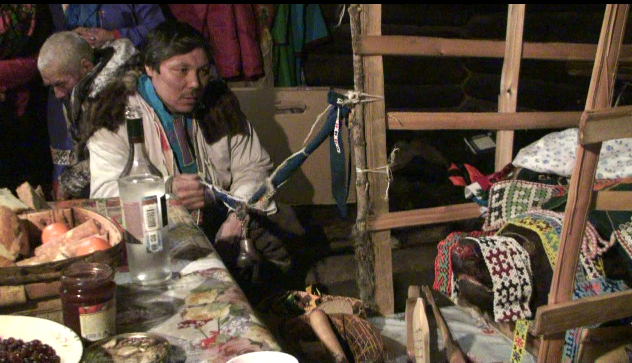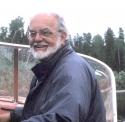By: Andrew Wiget, Professor Emeritus at New Mexico State University and Olga Balalaeva, Independent Scholar.
Overview:
For centuries, Indigenous peoples across Eurasia and North American have maintained harmonious relations with bears with whom they share the world 1, honoring this relationship through ceremonies. A current NSF-funded project Waking the Bear, led by Andrew Wiget with Olga Balalaeva, explores the range of traditional practices. The project website, supported by the Exchange for Local Observations and Knowledge of the Arctic (ELOKA), describes the bear ceremonies of Siberian people, the Mansi and the Khanty, through narrative, photos, videos, and audio recordings. The content is in both English and Russian.
Bear ceremonialism refers to a range of traditional practices by which Indigenous peoples across Eurasia and North America have maintained relations with bears. These practices include carved or painted images, special bear language, and preserved elements of the bear. While some peoples entirely refuse to hunt bears, among other peoples, the bear is understood to offer himself to men in death. Such a death is followed by an elaborate sending home ceremony, in which the bear is made a guest in the house and celebrated for one or more days before being sent back to his sky-home. Such is the practice among the Indigenous Khanty and Mansi peoples of western Siberia.

During our 30 years of working among the Indigenous Khanty and Mansi peoples 2, our principal Khanty collaborator was Petr Vassilievich Kurlomkin, the last Bear Festival singer among the Eastern Khanty of the B. Yugan River. When he passed away in 2013, there were no more Bear Festival singers for the whole Yugan Khanty community. While Bear Festival traditions among the Northern Khanty appeared to be thriving, and those of the Northern Mansi were doing well, the situation with among the eastern Khanty had become especially acute. With support from UNESCO's Moscow office, we established a community-based cultural heritage program and initiated a master-apprentice program that realized the first performance of the Bear Ceremony in 25 years among the Yugan Khanty in March 2010, and a second in 2016.

That work led us to meet with Indigenous Khanty and Mansi experts and involve them in the present project in order to help scientists and the public understand the value of bear ceremonialism among Indigenous peoples of northern Eurasia and North America, and how bears are met as other-than-human persons who have social relations, communication, interests, motivations, memories, and histories. Today, stresses such as commercial hunting, land use policies, and other forces that turn the living world into commodities are eroding this way of thinking. These disruptions come at a time when effective policy-making depends upon understanding and accommodating these different ways of seeing and being in the world.

The most public face of our NSF-funded research is a just-opened media-rich website, Waking the Bear: Understanding Circumpolar Bear Ceremonialism. Developed in close collaboration with Indigenous experts, it features extensive media documentation of bear ceremonialism, community history and lifeways, personal and traditional narratives, and for the first time, trilingual bear song texts (Native language, Russian, and English), transcribed and translated from actual bear festival ceremonies, elements of which appear on the page in video. Annotated with references to scholarly resources, it is organized geographically, beginning with the bear ceremonies of the Khanty and Mansi peoples. The site is fully bilingual, even to the captioning of photos and videos, to support access whether the principal shared language is English or Russian. The website is Produced and hosted by ELOKA and designed to be accessible on platforms ranging from laptops to tablets and smartphones.
This work is funded by a grant to New Mexico State University from the National Science Foundation, Award Number 1724508, Office of Polar Programs, under the title, "An Anthropological and Linguistic Investigation of Arctic Ceremonial Traditions," and directed by Andrew Wiget. The NSF team members include Finno-Ugric Studies specialist Olga Balalaeva, Hungarian linguist Marta Csepregi, Northern Khanty experts Tatiana Moldanova and Timofei Moldanov, Northern Mansi expert Svetlana Popova, and Eastern Khanty experts Agrafena Sopochina and Elena Surlomkina.
In the next two years of the project, we aim to have conversations with Native American and First Nations communities, to better understand the ways in which they have learned to manage their relationship to bears in this rapidly changing world (such as The Grizzly Bear Treaty, initiated by the Piikani First Nation in Canada). We hope that the project may assist the formation of an international, multidisciplinary, Indigenous-led forum for dialogue on sharing the world with bears.
About the Authors
 Andrew Wiget, Professor Emeritus at New Mexico State University, is a folklorist and ethnographer whose work began with Indian tribes in the Southwest. In 1992, he partnered with Olga Balalaeva to begin joint ethnographic work in Siberia. He can be contacted at andrew.wiget [at] gmail.com.
Andrew Wiget, Professor Emeritus at New Mexico State University, is a folklorist and ethnographer whose work began with Indian tribes in the Southwest. In 1992, he partnered with Olga Balalaeva to begin joint ethnographic work in Siberia. He can be contacted at andrew.wiget [at] gmail.com.
 Olga Balalaeva, is a specialist in Finno-Ugrian studies. She has been working among the Khanty and Mansi in Western Siberia for the past 30 years. She can be contacted at o.balalaeva [at] gmail.com.
Olga Balalaeva, is a specialist in Finno-Ugrian studies. She has been working among the Khanty and Mansi in Western Siberia for the past 30 years. She can be contacted at o.balalaeva [at] gmail.com.
End Notes
Hallowell, A. I., 1926. Bear ceremonialism in the northern hemisphere. American Anthropologist, n.s., 28: 1-175
Wiget, A. and O. Balalaeva, 2011. Khanty, People of the Taiga: Surviving the Twentieth Century. Fairbanks: U of Alaska P, 2011.
